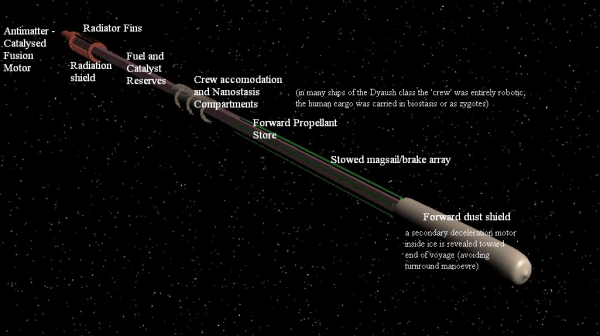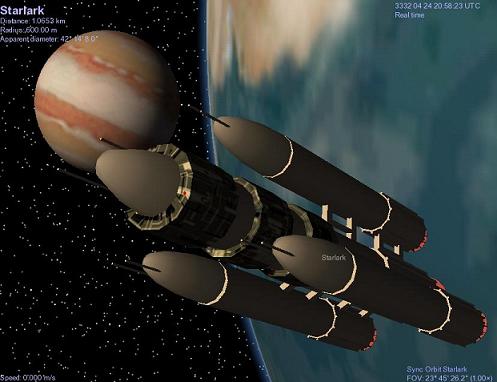BY LETTER
Antimatter Catalysed Fusion
Technology > Application > Transportation > Interplanetary Transport
Technology > Application > Transportation > Interstellar Transport
Technology > Application > Transportation > Propulsion Technology
Technology > Application > Transportation > Interstellar Transport
Technology > Application > Transportation > Propulsion Technology
Propulsion using fusion boosted by relatively small amounts of antimatter |
 Image from Steve Bowers |
Antimatter Catalyzed Fusion - Data Panel | |
| Summary: | Hybrid anti-matter-fusion engine. Although it has a lower exhaust velocity and Isp than the pure amat engine, this type of craft is excellent for exploring interplanetary space, as far out as the Oort Cloud. There are a number of variants. Also called the Antimatter Catalyzed Fusion Engine |
|---|---|
| Basic Propulsion: | Reaction |
| Specific Impulse | 10e3 to 10e6 sec (depending on the amount of anti-matter used, and the design and efficiency of the engine). |
| Fuel: | amat (antiprotons) and fusion fuel (see Fusion Drive) |
| Minimum Technology Required: | Middle to High Tech (Information/Interplanetary Age Equivalent) |
| Matter Manipulation: | microscale |
| Controller required: | advanced non-sentient or sentient computers |
| First Introduced: | Late Information Age (early small-scale unmanned probes). During the late Interplanetary Age and the Early First Federation period these ships were common in the Inner Solar System, these ships are also widely used for fast runs in the outer system; most antimatter produced in the inner solar system was traded for use in Amat/Cat ships. During the Great Expulsion period many Backyarder vessels used the Amat/Cat drive to escape the Solar System, despite the relatively poor performance compared to later, more efficient drives. Timeline. 263 AT - First manned Antimatter Catalysed Fusion spacecraft 365 AT - First manned interstellar colony space craft (the Tsiolkovsky, an antimatter catalysed fusion /plasma sail hybrid a.t. - launched toward Tau Ceti (Nova Terra ) 960 - Efficient Pion-catalysed Fusion drive allows faster colony ships and interplanetary transport |
| Used by: | still widely used for cheap interplanetary transport on many Middle and some High Tech systems. |
| Used in: | medium speed interplanetary transport/ slow interstellar transport |
| Construction Costs: | Autofac: medium (bulky, precision materials); Hylonano: reasonably cheap assuming presence of component raw materials |
| Advantages: | robust lower tech, does not require amat reactor chamber, smaller and cheaper to build than a fusion pulse engine of similar power, gives better performance, does not require advanced tech or high level AI. |
| Disadvantages: | slow, requires amat (hazardous) |
| Normal Acceleration: | 0.01 to 1 g |
| Normal Top Cruising Speed | 100 - 150 km/sec (interplanetary haulers) (0.1c -interstellar arkships) |
| Drive Details | Antimatter Catalyzed Fusion - uses antimatter to initiate nuclear fusion. Hydrogen is forced into fusion by catalysis with antimatter |
Antimatter-catalyzed Fusion became important in the Late Interplanetary age, following a brief flowering of antimatter-catalyzed fission designs (Antiproton Catalyzed Microfission and Ion Compressed Antimatter Nuclear). The Antimatter catalyzed fusion rocket was just powerful enough to allow interstellar missions of up to 0.1c, and the Starlark design developed after the Great Expulsion allowed for additional antimatter to be introduced into the reaction chamber after fusion to further boost the rocket. Many of the ships that took the refugees from the Solar System in this period were powered by antimatter-catalyzed fusion.
 Image from Steve Bowers | |
| The Starlark, an antimatter catalysed fusion arkship | |
Where amat is scarce or expensive, or where ships carrying large quantities of amat are not allowed, and thus standard amat drive impractical, the antimatter catalyzed fusion (or antimatter-thermal) rocket is a common option. An antiproton catalyzed fusion rocket uses antiprotons to provide the energy and induce a fusion reaction much more easily than a normal fusion reaction. Relatively few antiprotons are needed to catalyze this reaction, so hundreds of thousands of kilograms of antiprotons are not be needed, as in the case of the pure matter-antimatter rocket. In the "pion-catalysed" design the antimatter reaction generates pions, about 2/3 of which are charged. A strong magnetic field deflects these charged pions so that they exhaust out the back in a so called 'beamed core'.
See also True Antimatter Drives
Related Articles
Appears in Topics
Development Notes
Text by M. Alan Kazlev and Steve Bowers
Initially published on 08 December 2008.
Antimatter-Driven Fusion Propulsion Scheme for Solar System Exploration - T. Kammash and D.L. Galbraith
Initially published on 08 December 2008.
Antimatter-Driven Fusion Propulsion Scheme for Solar System Exploration - T. Kammash and D.L. Galbraith






